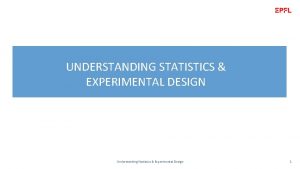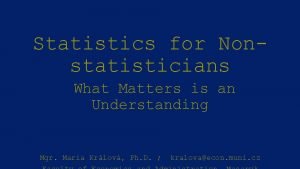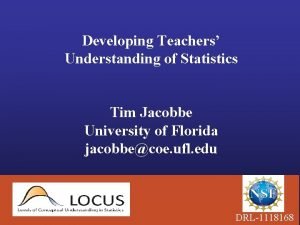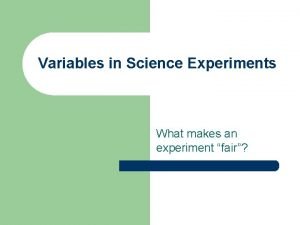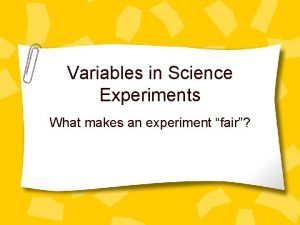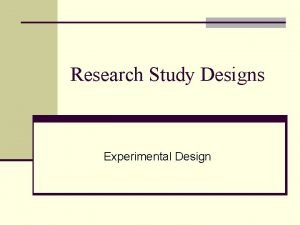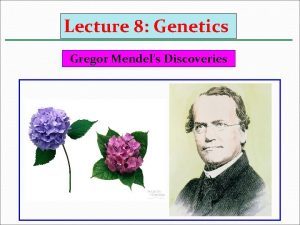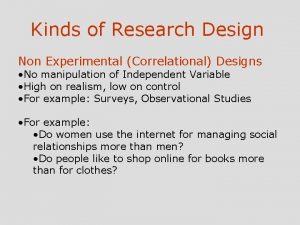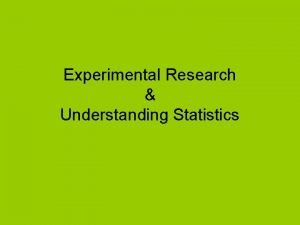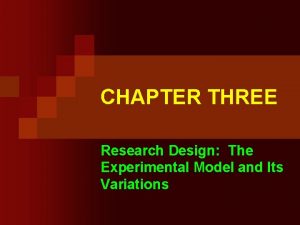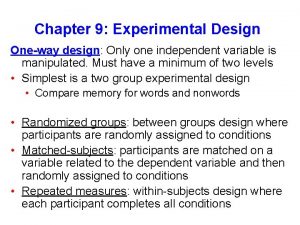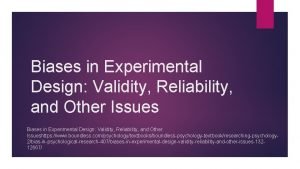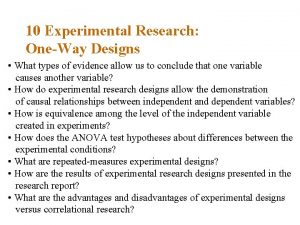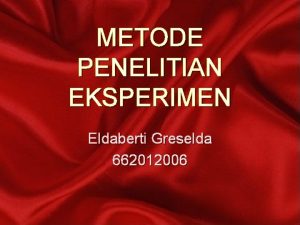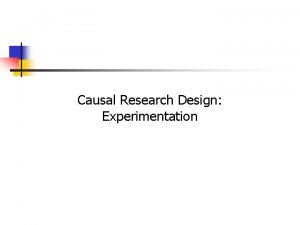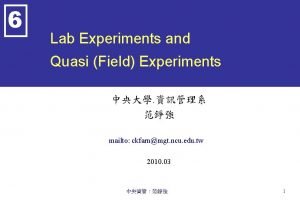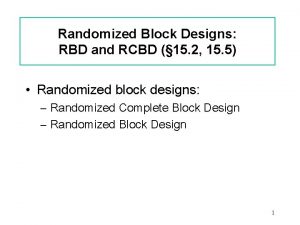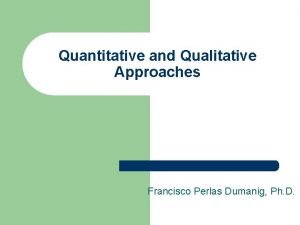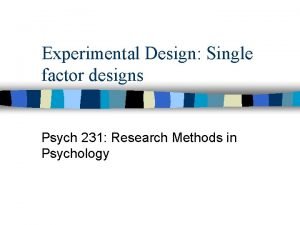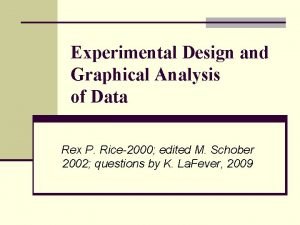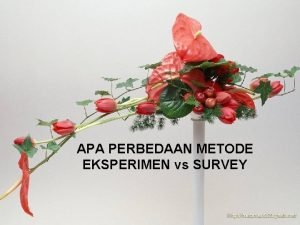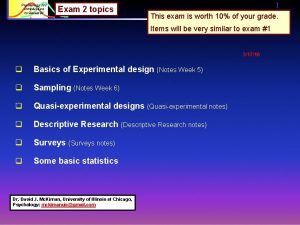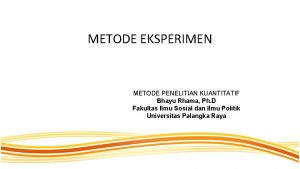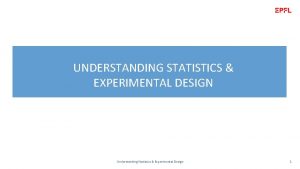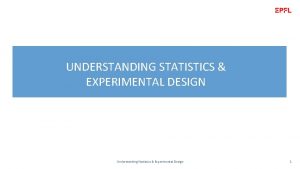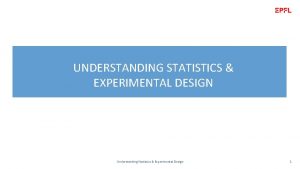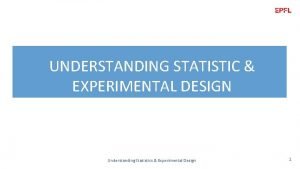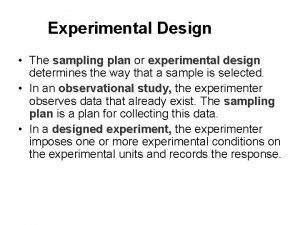UNDERSTANDING STATISTICS EXPERIMENTAL DESIGN Understanding Statistics Experimental Design





















































- Slides: 53

UNDERSTANDING STATISTICS & EXPERIMENTAL DESIGN Understanding Statistics & Experimental Design 1

Content 1. Basic Probability Theory 2. Signal Detection Theory (SDT) 3. SDT and Statistics I and II 4. Statistics in a nutshell 5. Multiple Testing 6. ANOVA 7. Experimental Design & Statistics 8. Correlations & PCA 9. Meta-Statistics: Basics 10. Meta-Statistics: Too good to be true 11. Meta-Statistics: How big a problem is publication bias? 12. Meta-Statistics: What do we do now? Understanding Statistics & Experimental Design 2

Replication and hypothesis testing Understanding Statistics & Experimental Design 3

Experimental Methods Suppose you hear about two sets of experiments that investigate phenomena A and B Which effect is more believable? Number of experiments that reject H 0 Replication rate Effect A Effect B 10 19 9 10 0. 9 0. 53 Understanding Statistics & Experimental Design 4

Replication Effect A is Bem’s (2011) precognition study that reported evidence of people’s ability get information from the future I do not know any scientist who believes this effect is real Effect B is from a meta-analysis of the bystander effect, where people tend to not help someone in need if others are around I do not know any scientist who does not believe this is a real effect So why are we running experiments? Effect A Effect B Number of experiments 10 19 Number of experiments that reject H 0 9 10 0. 9 0. 53 Replication rate Understanding Statistics & Experimental Design 5

Replication has long been believed to be the final arbiter of phenomena in science But it seems to not work Not sufficient (Bem, 2011) Not necessary (bystander effect) In a field that depends on hypothesis testing, like experimental psychology, some effects should be rejected because they are so frequently replicated Understanding Statistics & Experimental Design 6

Hypothesis Testing (For Means) We start with a null hypothesis: no effect, H 0 Identify a sampling distribution that describes variability in a test statistic Understanding Statistics & Experimental Design 7

Hypothesis Testing (For Two Means) We can identify rare test statistic values as those in the tail of the sampling distribution If we get a test statistic in either tail, we say it is so rare (usually 0. 05) that we should consider the null hypothesis to be unlikely We reject the null Understanding Statistics & Experimental Design 8

Alternative Hypothesis If the null hypothesis is not true, then the data came from some other sampling distribution (H 1) Understanding Statistics & Experimental Design 9

Power If the alternative hypothesis is true Power is the probability you will reject H 0 If you repeated the experiment many times, you would expect to reject H 0 with a proportion that reflects the power Understanding Statistics & Experimental Design 10

Power and sample size The standard deviation of the sampling distribution is inversely related to the (square root of the) sample size Power increases with larger sample sizes Understanding Statistics & Experimental Design 11

Effect Size The difference between the null and alternative hypotheses can be characterized by a standardized effect size Understanding Statistics & Experimental Design 12

Effect Size Effect size does not vary with sample size although the estimate may become more accurate with larger samples Understanding Statistics & Experimental Design 13

Effect size and power Experiments with smaller effect sizes have smaller power Understanding Statistics & Experimental Design 14

Effect size Consider the 10 findings reported by Bem (2011) All experiments were measured as a one-sample t-test (one tail, Type I error rate of 0. 05) For each experiment, we can measure the standardized effect size (Hedges g) Where c(m) is a correction for small samples sizes (≈1) s is the sample standard deviation, is the sample mean μ 0 is the value in the null hypothesis Understanding Statistics & Experimental Design 15

Effect size Use meta-analytic techniques to pool the effect sizes across all ten experiments (Hedges & Olkin, 1985) Sample size Effect size (g) Exp. 1 100 0. 249 Exp. 2 150 0. 194 Exp. 3 97 0. 248 Exp. 4 Exp. 5 99 100 0. 202 0. 221 Exp. 6 Negative Exp. 6 Erotic 150 0. 146 0. 144 Exp. 7 200 0. 092 Exp. 8 100 0. 191 Exp. 9 50 0. 412 Pooled effect size g*=0. 1855 • wi is the inverse variance of the effect size estimate Understanding Statistics & Experimental Design 16

Power Use the pooled effect size to compute the power of each experiment (probability this experiment would reject the null hypothesis) Pooled effect Sample size Effect size (g) Power Exp. 1 100 0. 249 0. 578 Exp. 2 150 0. 194 0. 731 Exp. 3 97 0. 248 0. 567 Exp. 4 99 0. 202 0. 575 Exp. 6 Negative Exp. 6 Erotic 100 150 0. 221 0. 146 0. 144 0. 578 0. 731 Exp. 7 200 0. 092 0. 834 Exp. 8 100 0. 191 0. 578 Exp. 9 50 0. 412 0. 363 size g*=0. 1855 Understanding Statistics & Experimental Design 17

Power The sum of the power values (E=6. 27) is the expected number of times experiments like these would reject the null hypothesis (Ioannidis & Trikalinos, 2007) But Bem (2011) rejected the null O=9 out of 10 times! Sample size Effect size (g) Power Exp. 1 100 0. 249 0. 578 Exp. 2 150 0. 194 0. 731 Exp. 3 97 0. 248 0. 567 Exp. 4 99 0. 202 0. 575 Exp. 6 Negative Exp. 6 Erotic 100 150 0. 221 0. 146 0. 144 0. 578 0. 731 Exp. 7 200 0. 092 0. 834 Exp. 8 100 0. 191 0. 578 Exp. 9 50 0. 412 0. 363 Understanding Statistics & Experimental Design 18

Bias Test Use an exact test to consider the probability that any O=9 out of the 10 experiments would reject H 0 There are 11 such combinations of the experiments Their summed probability is only 0. 058 A criterion threshold for a bias test is usually 0. 1 (Begg & Mazumdar, 1994; Ioannidis & Trikalinos, 2007; Stern & Egger, 2001) Sample size Effect size (g) Power Exp. 1 100 0. 249 0. 578 Exp. 2 150 0. 194 0. 731 Exp. 3 97 0. 248 0. 567 Exp. 4 99 0. 202 0. 575 Exp. 6 Negative Exp. 6 Erotic 100 150 0. 221 0. 146 0. 144 0. 578 0. 731 Exp. 7 200 0. 092 0. 834 Exp. 8 100 0. 191 0. 578 Exp. 9 50 0. 412 0. 363 Understanding Statistics & Experimental Design 19

Interpretation The number of times Bem (2011) rejected the H 0 is inconsistent with the size of the reported effect and the properties of the experiments 1. Perhaps there were additional experiments that failed to reject H 0 but were not reported 2. Perhaps the experiments were run incorrectly in a way that rejected the H 0 too frequently 3. Perhaps the experiments were run incorrectly in a way that underestimated the true magnitude of the effect size The findings in Bem (2011) seem too good to be true Non-scientific set of findings Anecdotal Note, the effect may be true (or not), but the studies in Bem (2011) give no guidance Understanding Statistics & Experimental Design 20

Bystander Effect Fischer et al. (2011) described a meta-analysis of studies of the bystander effect Broke down studies according to emergency or non-emergency situations Understanding Statistics & Experimental Design 21

Bystander Effect l No suspicion of publication bias for non-emergency situations l l Effect “B” from the earlier slides Nonemergency situation Number of studies 65 19 Pooled effect size -0. 30 -0. 47 24 10 10. 02 10. 77 χ2(1) 23. 05 0. 128 p <. 0001 0. 721 Observed number of rejections of H 0 Clear indication of publication bias for emergency situations l Emergency situation consistent with bystander effect (O) Expected number of rejections of H 0 Even though fewer than half of the experiments reject H 0 consistent with bystander effect (E) Understanding Statistics & Experimental Design 22

Simulated Replications Two-sample t test Control group: draw n 1 samples from a normal distribution N(0, 1) Experimental group: drawn n 2=n 1 samples from a normal distribution N(0. 3, 1) The true effect size is 0. 3 Repeat for 20 experiments With random sample sizes n 2=n 1 drawn uniformly from [15, 50] Understanding Statistics & Experimental Design 23

Simulated Replications l Compute the pooled effect size l l g*=0. 303 Very close to true 0. 3 Power from true ES Power from pooled ES 0. 230 0. 202 0. 206 1. 380 0. 384 0. 180 0. 183 26 1. 240 0. 339 0. 186 0. 189 15 0. 887 0. 315 0. 126 42 0. 716 0. 155 0. 274 0. 279 n 1=n 2 t Effect size 29 0. 888 25 Power from biased ES 37 1. 960 0. 451 0. 247 0. 251 49 -0. 447 -0. 090 0. 312 0. 318 17 1. 853 0. 621 0. 136 0. 138 36 2. 036 0. 475 0. 241 0. 245 22 1. 775 0. 526 0. 163 0. 166 39 1. 263 0. 283 0. 258 0. 262 19 3. 048 0. 968 0. 147 0. 149 0. 444 18 2. 065 0. 673 0. 141 0. 143 0. 424 26 -1. 553 -0. 424 0. 186 0. 189 38 -0. 177 -0. 040 0. 252 0. 257 42 2. 803 0. 606 0. 274 0. 279 21 1. 923 0. 582 0. 158 0. 160 40 2. 415 0. 535 0. 263 0. 268 22 1. 786 0. 529 0. 163 0. 166 35 -0. 421 -0. 100 0. 236 0. 240 Understanding Statistics & Experimental Design 0. 718 0. 784 0. 764 24

Simulated Replications l Compute the pooled effect size l l l 0. 202 0. 206 1. 380 0. 384 0. 180 0. 183 26 1. 240 0. 339 0. 186 0. 189 15 0. 887 0. 315 0. 126 42 0. 716 0. 155 0. 274 0. 279 29 0. 888 g*=0. 303 25 Very close to true 0. 3 Power from biased ES 37 1. 960 0. 451 0. 247 0. 251 49 -0. 447 -0. 090 0. 312 0. 318 17 1. 853 0. 621 0. 136 0. 138 36 2. 036 0. 475 0. 241 0. 245 22 1. 775 0. 526 0. 163 0. 166 39 1. 263 0. 283 0. 258 0. 262 19 3. 048 0. 968 0. 147 0. 149 0. 444 18 2. 065 0. 673 0. 141 0. 143 0. 424 26 -1. 553 -0. 424 0. 186 0. 189 E(true)=4. 140 38 -0. 177 -0. 040 0. 252 0. 257 42 2. 803 0. 606 0. 274 0. 279 E(pooled)=4. 214 21 1. 923 0. 582 0. 158 0. 160 40 2. 415 0. 535 0. 263 0. 268 22 1. 786 0. 529 0. 163 0. 166 35 -0. 421 -0. 100 0. 236 0. 240 Observed rejections l 0. 230 Effect size Sum of power is expected number of times to reject l Power from pooled ES t Use effect size to compute power l Power from true ES n 1=n 2 O=5 0. 718 0. 784 0. 764 Σ = 4. 14 4. 214 Understanding Statistics & Experimental Design 25

Simulated Replications l Probability of observing O≥ 5 rejections for 20 experiments like these is l l 0. 407 for true ES 0. 417 for pooled ES • No indication of publication bias when all the experiments are fully reported Power from true ES Power from pooled ES 0. 230 0. 202 0. 206 1. 380 0. 384 0. 180 0. 183 26 1. 240 0. 339 0. 186 0. 189 15 0. 887 0. 315 0. 126 42 0. 716 0. 155 0. 274 0. 279 n 1=n 2 t Effect size 29 0. 888 25 Power from biased ES 37 1. 960 0. 451 0. 247 0. 251 49 -0. 447 -0. 090 0. 312 0. 318 17 1. 853 0. 621 0. 136 0. 138 36 2. 036 0. 475 0. 241 0. 245 22 1. 775 0. 526 0. 163 0. 166 39 1. 263 0. 283 0. 258 0. 262 19 3. 048 0. 968 0. 147 0. 149 0. 444 18 2. 065 0. 673 0. 141 0. 143 0. 424 26 -1. 553 -0. 424 0. 186 0. 189 38 -0. 177 -0. 040 0. 252 0. 257 42 2. 803 0. 606 0. 274 0. 279 21 1. 923 0. 582 0. 158 0. 160 40 2. 415 0. 535 0. 263 0. 268 22 1. 786 0. 529 0. 163 0. 166 35 -0. 421 -0. 100 0. 236 0. 240 0. 718 0. 784 0. 764 Σ = 4. 14 4. 214 Understanding Statistics & Experimental Design 26

Simulated File Drawer l l Suppose a researcher only published the experiments that rejected the null hypothesis l l Power from pooled ES 0. 230 0. 202 0. 206 1. 380 0. 384 0. 180 0. 183 26 1. 240 0. 339 0. 186 0. 189 15 0. 887 0. 315 0. 126 42 0. 716 0. 155 0. 274 0. 279 t Effect size 29 0. 888 25 Power from biased ES 37 1. 960 0. 451 0. 247 0. 251 49 -0. 447 -0. 090 0. 312 0. 318 17 1. 853 0. 621 0. 136 0. 138 g*=0. 607 36 2. 036 0. 475 0. 241 0. 245 22 1. 775 0. 526 0. 163 0. 166 Double the true effect! 39 1. 263 0. 283 0. 258 0. 262 19 3. 048 0. 968 0. 147 0. 149 0. 444 18 2. 065 0. 673 0. 141 0. 143 0. 424 26 -1. 553 -0. 424 0. 186 0. 189 38 -0. 177 -0. 040 0. 252 0. 257 42 2. 803 0. 606 0. 274 0. 279 21 1. 923 0. 582 0. 158 0. 160 40 2. 415 0. 535 0. 263 0. 268 22 1. 786 0. 529 0. 163 0. 166 35 -0. 421 -0. 100 0. 236 0. 240 The pooled effect size is now l Power from true ES n 1=n 2 Also increases the estimated power of the reported experiments 0. 718 0. 784 0. 764 Σ = 4. 14 4. 214 Understanding Statistics & Experimental Design 27

Simulated File Drawer l The sum of power values is again the expected number of times the null hypothesis should be rejected l l l E(biased)=3. 135 Compare to O=5 The probability of 5 experiments like these all rejecting the null is the product of the power terms l l 0. 081 (<0. 1) Indicates publication bias Power from true ES Power from pooled ES 0. 230 0. 202 0. 206 1. 380 0. 384 0. 180 0. 183 26 1. 240 0. 339 0. 186 0. 189 15 0. 887 0. 315 0. 126 42 0. 716 0. 155 0. 274 0. 279 n 1=n 2 t Effect size 29 0. 888 25 Power from biased ES 37 1. 960 0. 451 0. 247 0. 251 49 -0. 447 -0. 090 0. 312 0. 318 17 1. 853 0. 621 0. 136 0. 138 36 2. 036 0. 475 0. 241 0. 245 22 1. 775 0. 526 0. 163 0. 166 39 1. 263 0. 283 0. 258 0. 262 19 3. 048 0. 968 0. 147 0. 149 0. 444 18 2. 065 0. 673 0. 141 0. 143 0. 424 26 -1. 553 -0. 424 0. 186 0. 189 38 -0. 177 -0. 040 0. 252 0. 257 42 2. 803 0. 606 0. 274 0. 279 21 1. 923 0. 582 0. 158 0. 160 40 2. 415 0. 535 0. 263 0. 268 22 1. 786 0. 529 0. 163 0. 166 35 -0. 421 -0. 100 0. 236 0. 240 0. 718 0. 784 0. 764 Σ = 4. 14 4. 214 3. 135 Understanding Statistics & Experimental Design 28

Simulated File Drawer l l l The test for publication bias works properly But it is conservative If the test indicates bias, we can be fairly confident it is correct Understanding Statistics & Experimental Design 29

Statistical Errors l l Even if an effect is truly zero, a random sample will sometimes produce a significant effect (false alarm: α) Even if an effect is non-zero, a random sample will not always produce a statistically significant effect (miss: β=1 -power) A scientist who does not sometimes make a mistake with statistics is doing it wrong Women Men There can be excess success Understanding Statistics & Experimental Design 30

Simulated Optional Stopping l There are other types of biases l Set true effect size to 0 l Optional stopping: t Effect size Power from pooled ES Power from file drawer ES 19 2. 393 0. 760 0. 053 0. 227 100 0. 774 0. 109 0. 066 100 1. 008 0. 142 0. 066 63 2. 088 0. 370 0. 060 100 0. 587 0. 083 0. 066 Take sample of n 1=n 2=15 100 -1. 381 -0. 195 0. 066 -0. 481 -0. 068 0. 066 l Run hypothesis test 100 0. 359 0. 051 0. 066 If reject null or n 1=n 2 =100, stop and report 100 -1. 777 -0. 250 0. 066 l 100 -0. 563 -0. 079 0. 066 100 1. 013 0. 143 0. 066 100 -0. 012 -0. 002 0. 066 46 2. 084 0. 431 0. 057 100 0. 973 0. 137 0. 066 100 -0. 954 -0. 134 0. 066 100 -0. 136 -0. 019 0. 066 78 2. 052 0. 327 0. 062 100 -0. 289 -0. 041 0. 066 100 1. 579 0. 222 0. 066 100 0. 194 0. 027 0. 066 l l l n 1=n 2 Otherwise, add one more sample to each group and repeat Just by random sampling, O=4 experiments reject the null hypothesis l Type I error rate of 0. 2, even though used α=0. 05 Understanding Statistics & Experimental Design 0. 611 0. 480 0. 704 31

Simulated Optional Stopping l Pooled effect size across all experiments is g*=0. 052 l l Sum of power values is E=1. 28 Probability of O≥ 4 is 0. 036 n 1=n 2 t Effect size Power from pooled ES Power from file drawer ES 19 2. 393 0. 760 0. 053 0. 227 100 0. 774 0. 109 0. 066 100 1. 008 0. 142 0. 066 63 2. 088 0. 370 0. 060 100 0. 587 0. 083 0. 066 100 -1. 381 -0. 195 0. 066 100 -0. 481 -0. 068 0. 066 100 0. 359 0. 051 0. 066 100 -1. 777 -0. 250 0. 066 100 -0. 563 -0. 079 0. 066 100 1. 013 0. 143 0. 066 100 -0. 012 -0. 002 0. 066 46 2. 084 0. 431 0. 057 100 0. 973 0. 137 0. 066 100 -0. 954 -0. 134 0. 066 100 -0. 136 -0. 019 0. 066 78 2. 052 0. 327 0. 062 100 -0. 289 -0. 041 0. 066 100 1. 579 0. 222 0. 066 100 0. 194 0. 027 0. 066 Understanding Statistics & Experimental Design Σ = 1. 28 0. 611 0. 480 0. 704 32

Simulated Optional Stopping l Pooled effect size across all experiments is g*=0. 052 l l l Sum of power values is E=1. 28 Probability of O≥ 4 is 0. 036 If add a file-drawer bias l g*=0. 402 l E=2. 02 l P=0. 047 n 1=n 2 t Effect size Power from pooled ES Power from file drawer ES 19 2. 393 0. 760 0. 053 0. 227 100 0. 774 0. 109 0. 066 100 1. 008 0. 142 0. 066 63 2. 088 0. 370 0. 060 100 0. 587 0. 083 0. 066 100 -1. 381 -0. 195 0. 066 100 -0. 481 -0. 068 0. 066 100 0. 359 0. 051 0. 066 100 -1. 777 -0. 250 0. 066 100 -0. 563 -0. 079 0. 066 100 1. 013 0. 143 0. 066 100 -0. 012 -0. 002 0. 066 46 2. 084 0. 431 0. 057 100 0. 973 0. 137 0. 066 100 -0. 954 -0. 134 0. 066 100 -0. 136 -0. 019 0. 066 78 2. 052 0. 327 0. 062 100 -0. 289 -0. 041 0. 066 100 1. 579 0. 222 0. 066 100 0. 194 0. 027 0. 066 Understanding Statistics & Experimental Design Σ = 1. 28 0. 611 0. 480 0. 704 2. 02 33

Simulated Optional Stopping bias l l l The test for publication bias works properly But it is conservative When the test indicates bias, it is almost always correct Understanding Statistics & Experimental Design 34

Data And Theory Elliot, Niesta Kayser, Greitemeyer, Lichtenfeld, Gramzow, Maier & Liu (2010). Red, rank, and romance in women viewing men. Journal of Experimental Psychology: General Picked up by the popular press Understanding Statistics & Experimental Design 35

Data And Theory 7 successful experiments, three theoretical conclusions 1) Women perceive men to be more attractive when seen on a red background and in red clothing 2) Women perceive men to be more sexually desirable when seen on a red background and in red clothing 3) Changes in perceived status are responsible for these effects Understanding Statistics & Experimental Design 36

Analysis: Attractiveness l Pooled effect size is l l g*=0. 785 Every reported experiment rejected the null Description N 1 N 2 Effect size Power from pooled ES Given the power values, the expected number of rejections is E=2. 86 Exp. 1 10 11 0. 914 . 400 Exp. 2 20 12 1. 089 . 562 The estimated probability of five experiments like these to all reject the null is 0. 054 Exp. 3 16 17 0. 829 . 589 Exp. 4 27 28 0. 54 . 816 Exp. 7 12 15 0. 824 . 496 Understanding Statistics & Experimental Design 37

Analysis: Desirability l Pooled effect size is l l l g*=0. 744 Every reported experiment rejected the null The estimated probability of three experiments like these to all reject the null is 0. 191 N 2 Effect Power from size pooled ES Exp. 3 16 17 0. 826 . 544 Exp. 4 27 28 0. 598 . 773 Exp. 7 12 15 0. 952 . 455 Description Understanding Statistics & Experimental Design 38

Analysis: Status l Pooled effect size is l l l g*=0. 894 Every reported experiment rejected the null The estimated probability of three experiments like these to all reject the null is 0. 179 N 1 N 2 Effect Power from size pooled ES Exp. 5 a (present) 10 10 . 929 Exp. 5 a (potential) 10 10 1. 259 Exp. 6 19 18 0. 718 . 752 Exp. 7 12 15 0. 860 . 602 Description Understanding Statistics & Experimental Design . 395 39

Future Studies The probabilities for desirability and status do not fall below the 0. 1 threshold One more successful experimental result for these measures is likely to drop the power probability below the criterion These results will be most believable if a replication fails to show a statistically significant result But just barely fails A convincing fail will have a small effect size, which will pull down the estimated power of the other studies Understanding Statistics & Experimental Design 40

Theories From Data Elliot et al. (2010) proposed a theory Red influences perceived status, which then influences perceived attractiveness and desirability Such a claim requires (at least) that all three results be valid Several experiments measured these variables with a single set of subjects The data on these measures are correlated Total power is not just the product of probabilities Can recalculate power with provided correlations among variables Understanding Statistics & Experimental Design 41

Analysis: Correlated Data l l Every reported test rejected the null The estimated probability of 12 hypothesis tests in seven experiments like these to all reject the null is 0. 005 Description Power from pooled ES Exp. 1, Attractiveness, desirability . 400 Exp. 2, Attractiveness . 562 Exp. 3, Attractiveness, desirability . 438 Exp. 4, Attractiveness, desirability . 702 Exp. 5 a, Status . 395 Exp. 6 Status . 752 Exp. 7 Attractiveness, desirability, Understanding Statisticsstatus & Experimental Design . 237 42

Theories From Data Elliot et al. (2010) proposed a theory Red influences perceived status, which then influences perceived attractiveness and desirability This theory also generated five predicted null findings E. g. , Men do not show the effect of perceived attractiveness when rating other men If the null is true for these cases, the probability of all five tests not rejecting the null is (1 – 0. 05)5 = 0. 77 The theory never made a mistake in predicting the outcome of a hypothesis test The estimated probability of such an outcome is 0. 005 x 0. 77 = 0. 0038 Understanding Statistics & Experimental Design 43

Response From Elliot & Maier (2013) Lots of other labs have verified the red-attractiveness effect If these other studies form part of the evidence for their theory, they only strengthen the claim of bias (which now includes other labs) Conducted a replication study of Experiment 3 N 1=75 women judged attractiveness of men’s photos with red N 2=69 women judged attractiveness of men’s photos with gray Results: t= 1. 51, p=. 13, effect size = 0. 25 They conclude that the effect is real, but smaller than they originally estimated Implies that they do not believe in hypothesis testing. Understanding Statistics & Experimental Design 44

Analysis: Attractiveness 2 § Pooled effect size is § § § g*=0. 785 0. 532 N 1 N 2 Effect size Power from pooled ES Exp. 1 10 11 0. 914 . 400. 212 Exp. 2 20 12 1. 089 . 562. 297 Exp. 3 16 17 0. 829 . 589. 316 Exp. 4 27 28 0. 54 . 816. 491 Exp. 7 12 15 0. 824 . 496. 262 Replication 75 69 0. 251 . 887 Description Given the power values, the expected number of rejections is E=2. 86 2. 47 The estimated probability of five out of five six experiments like these to reject the null is 0. 054 0. 030 Understanding Statistics & Experimental Design 45

Analysis: Attractiveness 2’ § One could argue that the best estimate of the effect is from the replication experiment § § g*=0. 785 0. 532 0. 251 Given the power values, the expected number of rejections is E=2. 86 2. 47 0. 860 § The estimated probability of five out of five six experiments like these to reject the null is 0. 054 0. 030 0. 0002 § The estimated probability of the original Description N 1 N 2 Effect Power from pooled size ES Exp. 1 10 11 0. 914 . 400. 212. 085 Exp. 2 20 12 1. 089 . 562. 297. 103 Exp. 3 16 17 0. 829 . 589. 316. 107 Exp. 4 27 28 0. 54 . 816. 491. 149 Exp. 7 12 15 0. 824 . 496. 262. 095 Replication 75 69 0. 251 . 887. 320 5 experiments all being successful is 0. 000013 Understanding Statistics & Experimental Design 46

Analysis: Attractiveness 3 • • A recent meta-analysis (n=3, 381) (Lehmann, Elliot, Calin-Jageman, 2018) • Finds small effect size (d=0. 13) • Evidence of publication bias Two conclusions sections: • • First and Third Authors: “The simplest conclusion from our results is that the true effect of incidental red on attraction is very small, potentially nonexistent. ” Second Author: “Two primary weaknesses are that nearly all existing studies are underpowered and fail to attend to important color science procedures, especially regarding color production (e. g. , spectral assessment, matching color attributes) and presentation (e. g. , ambient illumination, background contrast; Elliot, 2015; Fairchild, 2015). Indeed, not a single published study that contributed to our main metaanalysis would be considered exemplary based on these two criteria alone. ” Understanding Statistics & Experimental Design 47

Power And Replication • Studies that depend on hypothesis testing can only detect a given effect with a certain probability • Due to random sampling • Even if the effect is true, you should sometimes fail to reject H 0 • The frequency of rejecting H 0 must reflect the underlying power of the experiments • When the observed number of rejections is radically different from what is to be expected, something is wrong (publication bias, optional stopping, something else) Understanding Statistics & Experimental Design 48

Good News • Many people get very concerned when their experimental finding is not replicated by someone else • Lots of accusations about incompetence and suppositions about who is wrong • But “failure” to replicate is expected when decisions are made with hypothesis testing • At a rate dependent on the experimental power • Statisticians have an obligation to be wrong the specified proportion of the time Understanding Statistics & Experimental Design 49

Conclusions Understanding Statistics & Experimental Design 50

Conclusions For a scientist, low power comes with great responsibility A scientist must resist the temptation to make the data show what they desire A scientist must not keep gathering data until finding what he desires A scientist must not try different analyses until finding one that shows what she wants. A scientist must resist drawing firm conclusions from noisy data Being a responsible scientist is easy when the signal is clear and noise is small (high power) Statistics is easy with large power. Understanding Statistics & Experimental Design 51

Take home messages Understanding Statistics & Experimental Design 52

END Class 10 Understanding Statistics & Experimental Design 53
 Statistics
Statistics Experimental vs nonexperimental research
Experimental vs nonexperimental research A bank wishes to survey its customers
A bank wishes to survey its customers Experimental vs non experimental
Experimental vs non experimental Solomon four group design
Solomon four group design Experimental vs non experimental research
Experimental vs non experimental research Nonexperimental study
Nonexperimental study Quotations or paraphrases used to support a point
Quotations or paraphrases used to support a point Understanding statistics
Understanding statistics Understanding statistics
Understanding statistics Introduction to statistics what is statistics
Introduction to statistics what is statistics What is independent variable in science
What is independent variable in science Experimental design independent and dependent variables
Experimental design independent and dependent variables Solomon four group design
Solomon four group design Quasi experimental design example
Quasi experimental design example N-of-1 study example
N-of-1 study example Non experimental research design
Non experimental research design Non experimental design
Non experimental design Types of quantitative research designs
Types of quantitative research designs Key principles of experimental design
Key principles of experimental design Are freckles recessive
Are freckles recessive Mendels three laws of inheritance
Mendels three laws of inheritance Mendel's experimental design
Mendel's experimental design Experimental research design
Experimental research design Mendel's experimental design
Mendel's experimental design Ethical issues of experimental research
Ethical issues of experimental research Random assignment vs selection
Random assignment vs selection Matched pair design
Matched pair design Anova excel
Anova excel Experimental design cheat sheet
Experimental design cheat sheet Solomon four group design
Solomon four group design Case control vs retrospective cohort
Case control vs retrospective cohort Rival causal factors
Rival causal factors One way experimental design
One way experimental design Mendel's experimental design
Mendel's experimental design Bias in experimental design
Bias in experimental design What is a one way design
What is a one way design Experimental design assistant
Experimental design assistant Pengertian pre experimental design
Pengertian pre experimental design Experimental research design types
Experimental research design types Experimental design
Experimental design Experimental design powerpoint
Experimental design powerpoint Experimental design questions and answers
Experimental design questions and answers Basic principles of experimental design
Basic principles of experimental design Experimental design xo1
Experimental design xo1 San diego science olympiad
San diego science olympiad Pre experimental design
Pre experimental design Rbd design example
Rbd design example What is research design
What is research design Single factor design
Single factor design How to linearize a side opening parabola
How to linearize a side opening parabola Jelaskan perbedaan metode eksperimen dan metode observasi
Jelaskan perbedaan metode eksperimen dan metode observasi Quasi experimental meaning
Quasi experimental meaning Quasi experimental design adalah
Quasi experimental design adalah
